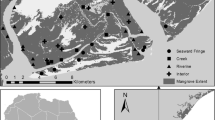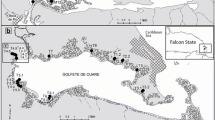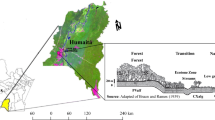Abstract
Purpose
Among environmental factors governing innumerous processes that are active in estuarine environments, those of edaphic character have received special attention in recent studies. With the objectives of determining the spatial patterns of soil attributes and components across different mangrove forest landscapes and obtaining additional information on the cause–effect relationships between these variables and position within the estuary, we analyzed several soil attributes in 31 mangrove soil profiles from the state of São Paulo (Guarujá, Brazil).
Materials and methods
Soil samples were collected at low tide along two transects within the Crumahú mangrove forest. Samples were analyzed to determine pH, Eh, salinity, and the percentages of sand, silt, clay, total organic carbon (TOC), and total S. Mineralogy of the clay fraction (<2 mm) was also studied by X-ray diffraction analysis, and partitioning of solid-phase Fe was performed by sequential extraction.
Results and discussion
The results obtained indicate important differences in soil composition at different depths and landscape positions, causing variations in physicochemical parameters, clay mineralogy, TOC contents, and iron geochemistry. The results also indicate that physicochemical conditions may vary in terms of different local microtopographies. Soil salinity was determined by relative position in relation to flood tide and transition areas with highlands. The proportions of TOC and total S are conditioned by the sedimentation of organic matter derived from vegetation and by the prevailing redox conditions, which clearly favored intense sulfate reduction in the soils (∼80% of the total Fe is Fe-pyrite). Particle-size distribution is conditioned by erosive/deposition processes (present and past) and probably by the positioning of ancient and reworked sandy ridges. The existing physicochemical conditions appear to contribute to the synthesis (smectite) and transformation (kaolinite) of clay minerals.
Conclusions
The results demonstrate that the position of soils in the estuary greatly affects soil attributes. Differences occur even at small scales (meters), indicating that both edaphic (soil classification, soil mineralogy, and soil genesis) and environmental (contamination and carbon stock) studies should take such variability into account.








Similar content being viewed by others
References
Aburto-Oropeza O, Ezcurra E, Danemann G, Valdez V, Murray J, Sala E (2008) Mangroves in the Gulf of California increase fishery yields. Proc Natl Acad Sci 105:10456–10459
Allison MA, Khan SR, Goodbred SL Jr, Kuehl SA (2003) Stratigraphic evolution of the late Holocene Ganges–Brahmaputra lower delta plain. Sediment Geol 155:317–342
Alongi DM (2009) The energetics of mangrove forest. Springer, Dordrecht
Behling H, Costa ML (2004) Mineralogy, geochemistry, and palynology of modern and late Tertiary mangrove deposits in the Barreiras Formation of Mosqueiro Island, northeastern Pará state, eastern Amazonia. J S Am Earth Sci 17:285–295
Berner RA (1970) Sedimentary pyrite formation. Am J Sci 268:1–23
Brookins DG (1988) Eh–pH diagrams for geochemistry. Springer, Berlin
Cintrón G, Schaeffer-Novelli Y (1983) Introducción a la ecologia del manglar. Rostlac, San Juan, p 109
Clough BF (1992) Primary productivity and growth of mangrove forests. In: Robertson AI, Alongi DM (eds) Coastal and estuarine studies. American Geophysical Union, Washington, pp 225–250
Constanza R, D'arge R, De Groot R, Farber S, Grasso M, Hannon B, Limburg K, Naeem S, O'Neill RVO, Paruelo J, Raskin RG, Sutton P, van den Belt M (1998) The value of the world's ecosystem services and natural capital. Ecol Econ 25:3–15
Costa ML, Behling H, Berrêdo JF, Carmo MS, Siqueira NVM (2004) Mineralogical, geochemical and palynological studies of late Holocene mangrove sediments from northeastern Pará State, Brazil. Braz J Geosci 34:479–488
FAO (2006) Guidelines for soil description, 4th edn. FAO, Rome
Ferreira TO, Otero XL, Vidal-Torrado P, Macías M (2007a) Redox processes in mangrove soils under Rhizophora mangle in relation to different environmental conditions. Soil Sci Soc Am J 71:484–491
Ferreira TO, Otero XL, Vidal-Torrado P, Macias F (2007b) Effects of bioturbation by root and crab activity on iron and sulfur biogeochemistry in mangrove substrate. Geoderma 142:36–46
Ferreira TO, Vidal-Torrado P, Otero XL, Macias F (2007c) Are mangrove substrate sediments or soils? A case study in southeastern Brazil. Catena 70:79–91
Fortin D, Leppard GG, Tessier A (1993) Characteristics of lacustrine diagenetic iron oxyhydroxides. Geochim Cosmochim Acta 57:4391–4404
Furian S, Barbiéro L, Boulet R, Curmi P, Grimaldi M, Grimaldi C (2002) Distribution and dynamics of gibbsite and kaolinite in an oxisol of Serra do Mar, southeastern Brazil. Geoderma 106:83–100
Gee GW, Bauder JW (1986) Particle-size analysis. In: Klute A (ed) Methods of soil analysis: Part 1. Physical and mineralogical methods. American Society of Agronomy and Soil Science Society of America, Madison, pp 383–412
Gleason SM, Ewel KC, Hue N (2003) Soil redox conditions and plant–soil relationships in a Micronesian mangrove forest. Estuar Coast Shelf Sci 56:1065–1074
Huerta-Díaz MA, Morse JW (1990) A quantitative method for determination of trace metals in anoxic marine sediments. Mar Chem 29:119–144
Huerta-Díaz MA, Morse JW (1992) Pyritization of trace metals in anoxic marine sediments. Geochim Cosmochim Acta 56:2681–2702
Jackson ML (1969) Soil chemical analysis: an advanced course. Chapman and Hall, Madison, p 894
Ke L, Wong TWY, Wong YS, Tam NFY (2002) Fate of polycyclic aromatic hydrocarbon (PAH) contamination in a mangrove swamp in Hong Kong following an oil spill. Mar Pollut Bull 45:339–347
Lacerda LD (2002) Mangrove ecosystems. Function and management, Springer, Berlin
Lamberti A (1966) Contribuição ao conhecimento da ecologia das plantas do manguezal de Itanhaém (in Portuguese). Dissertation, Universidade de São Paulo São Paulo, São Paulo
Machado W, Moscatelli M, Rezende LG, Lacerda LD (2002) Mercury, zinc, and copper accumulation in mangrove sediments surrounding a large landfill in southeast Brazil. Environ Pollut 120:455–461
Machado W, Carvalho MF, Santelli RE, Maddock JEL (2004) Reactive sulfides relationship with metals in sediments from an eutrophicated estuary in Southeast Brazil. Mar Pollut Bull 49:89–92
Mackin JE, Swider KT (1989) Organic-matter decomposition pathways and oxygen consumption in coastal marine sediments. J Mar Res 47:681–716
Marchand C, Baltzer F, Lallier-Vergès E, Albéric P (2004) Pore–water chemistry in mangrove sediments: relationship with species composition and developmental stages (French Guiana). Mar Geol 208:361–381
Marius C, Lucas J (1991) Holocene mangrove swamps of West Africa: sedimentology and soils. J Afr Earth Sci 12:41–54
Morse JW, Thomson H, Finneran DW (2007) Factors controlling sulfide geochemistry in sub-tropical estuarine and bay sediments. Aquat Geochem 13:143–156
Otero XL, Macías F (2002) Variation with depth and season in metal sulfides in salt marsh soils. Biogeochemistry 61:247–268
Otero XL, Ferreira TO, Vidal-Torrado P, Macías F (2006) Spatial variation in pore water geochemistry in a mangrove system (Pai Matos island, Cananneia—Brazil). Appl Geochem 21:2171–2186
Otero XL, Ferreira TO, Huerta-Díaz MA, Partiti CSM, Souza Júnior V, Vidal-Torrado P, Macías F (2009) Geochemistry of iron and manganese in soils and sediments of a mangrove system, Island of Pai Matos (Cananeia—SP, Brazil). Geoderma 148:318–335
Postma D, Jakobsen R (1996) Redox zonation: equilibrium constraints on the Fe (III)/SO −4 reduction interface. Geochim Cosmochim Acta 17:3169–3175
Prada-Gamero RM, Vidal-Torrado P, Ferreira TO (2004) Mineralogia e Físico-Química dos Solos de Mangue do Rio Iriri no Canal de Bertioga (Santos, SP). Braz J Soil Sci 28:233–244
Prakasa RM, Swamy ASR (1987) Clay mineral distribution in the mangrove of the Godavari delta. Clay Res 6:81–86
Rhoades JD (1996) Salinity: electrical conductivity and total dissolved solids. In: Sparks DL (ed) Methods of soil analysis: Part 3. Chemical methods. SSSA, Madison, pp 417–435
Roden EE (2004) Analysis of long-term bacterial vs. chemical Fe(III) oxide reduction kinetics. Geochim Cosmochim Acta 61:3205–3216
Sherman RE, Fahey TJ, Howarth RW (1998) Soil–plant interactions in a neotropical mangroves forest: iron, phosphorus and sulfur dynamics. Oecologia 115:553–563
Sherman RE, Fahey TJ, Martinez P (2003) Spatial patterns of biomass and aboveground net primary productivity in a mangrove ecosystem in the Dominican Republic. Ecosystem 6:384–398
Souza Júnior V, Vidal-Torrado P, González Tessler M, Ruiz Pessenda LC, Ferreira TO, Otero XL, Macías F (2007) Evolução quaternária, distribuição de partículas nos solos e ambientes de sedimentaçao em manguezais do estado de São Paulo. Braz J Soil Sci 31:753–769
Souza Júnior V, Vidal-Torrado P, García-González MT, Otero XL, Macías F (2008) Soil mineralogy of mangrove forests from the state of São Paulo, southeastern Brazil. Soil Sci Soc Am J 72:848–857
Suguio K, Martin L (1978) Formações quaternárias marinhas do litoral paulista e sul fluminense. Instituto Oceanográfico, São Paulo, p 55
Tessier A, Campbell PGC, Bisson M (1979) Sequential extraction procedure for the speciation of particulate trace metals. Anal Chem 5:844–855
Velde B, Church T (1999) Rapid clay transformations in Delaware salt marshes. Appl Geochem 14:559–568
Vilarrúbia TV (2000) Zonation pattern of an isolated mangrove community at Playa Medina, Venezuela. Wetl Ecol Manage 8:9–17
Vilhena MDP, Costa MLD, Berrêdo JF (2010) Continental and marine contributions to formation of mangrove sediments in an eastern Amazonian mudplain: the case of the Marapanim Estuary. J S Am Earth Sci 29(2):427–438
Wolanski E, Gibbs R, Spagnol S, King B, Brunskill G (1998) Inorganic sediment budget in the mangrove-fringed Fly River delta, Papua New Guinea. Mangroves Salt Marshes 2:85–98
Acknowledgements
The present study was financed by the Brazilian Government (CAPES and FAPESP) and by the Spanish Government (Dirección General de Universidades del Ministerio de Educación y Ciencia; HBP-2002-0056 PC). We thank María Santiso for laboratory assistance.
Author information
Authors and Affiliations
Corresponding author
Additional information
Responsible editor: Chris Johnson
Rights and permissions
About this article
Cite this article
Ferreira, T.O., Otero, X.L., de Souza Junior, V.S. et al. Spatial patterns of soil attributes and components in a mangrove system in Southeast Brazil (São Paulo). J Soils Sediments 10, 995–1006 (2010). https://doi.org/10.1007/s11368-010-0224-4
Received:
Accepted:
Published:
Issue Date:
DOI: https://doi.org/10.1007/s11368-010-0224-4




